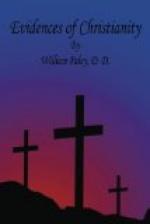CHAPTER III.
The candour of the writers of the new testament.
I make this candour to consist in their putting down many passages, and noticing many circumstances, which no writer whatever was likely to have forged; and which no writer would have chosen to appear in his book who had been careful to present the story in the most unexceptionable form, or who had thought himself at liberty to carve and mould the particulars of that story according to his choice, or according to his judgment of the effect.
A strong and well-known example of the fairness of the evangelists offers itself in their account of Christ’s resurrection, namely, in their unanimously stating that after he was risen he appeared to his disciples alone. I do not mean that they have used the exclusive word alone; but that all the instances which they have recorded of his appearance are instances of appearance to his disciples; that their reasonings upon it, and allusions to it, are confined to this supposition; and that by one of them Peter is made to say, “Him God raised up the third day, and showed him openly, not to all the people, but to witnesses chosen before of God, even to us who did eat and drink with him after he rose from the dead.” (Acts x. 40, 41.) The most common understanding must have perceived that the history of the resurrection would have come with more advantage if they had related that Jesus appeared, after he was risen, to his foes as well as his friends, to the scribes and Pharisees, the Jewish council, and the Roman governor: or even if they had asserted the public appearance of Christ in general unqualified terms, without noticing, as they have done, the presence of his disciples on each occasion, and noticing it in such a manner as to lead their readers to suppose that none but disciples were present. They could have represented in one way as well as the other. And if their point had been to have their religion believed, whether true or false; if they had fabricated the story ab initio; or if they had been disposed either to have delivered their testimony as witnesses, or to have worked up their materials and information as historians, in such a manner as to render their narrative as specious and unobjectionable as they could; in a word, if they had thought of anything but of the truth of the case, as they understood and believed it; they would in their account of Christ’s several appearances after his resurrection, at least have omitted this restriction. At this distance of time, the account as we have it is perhaps more credible than it would have been the other way; because this manifestation of the historians’ candour is of more advantage to their testimony than the difference in the circumstances of the account would have been to the nature of the evidence. But this is an effect which the evangelists would not foresee: and I think that it was by no means the case at the time when the books were composed.




